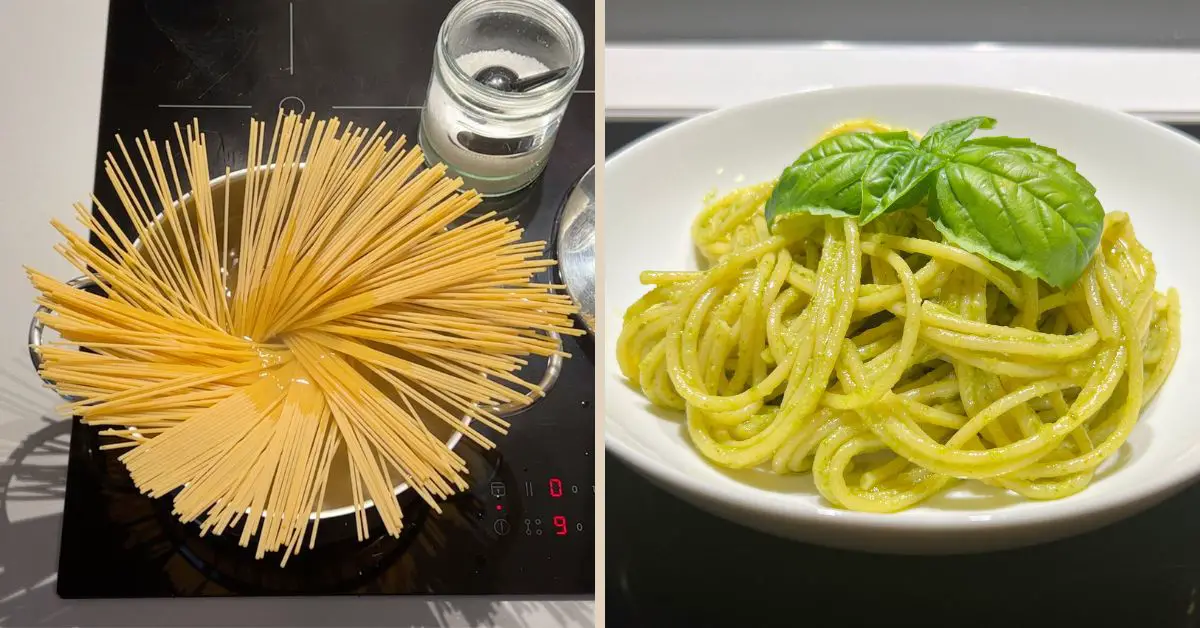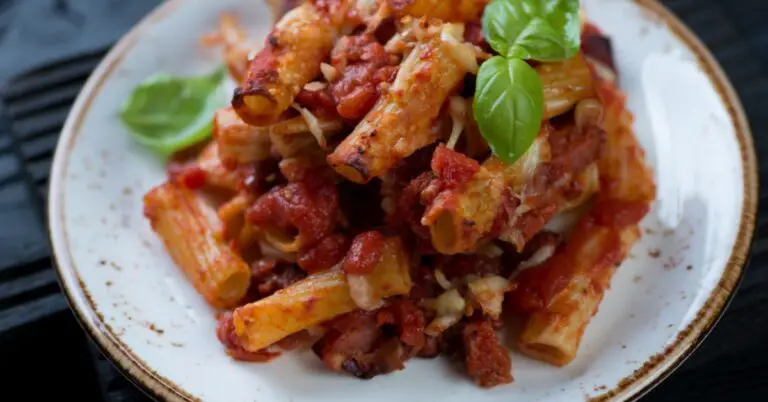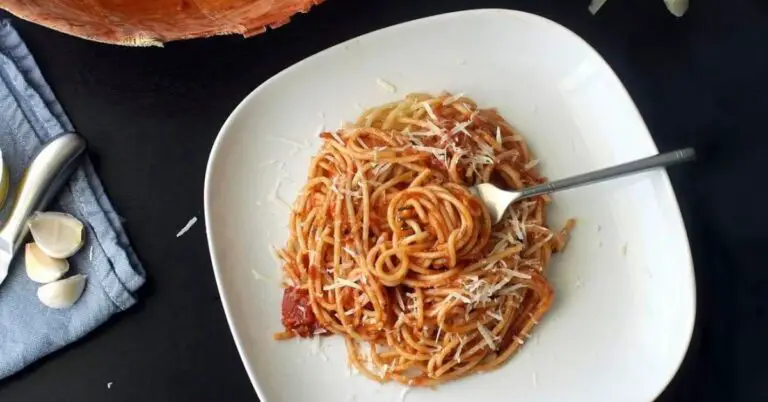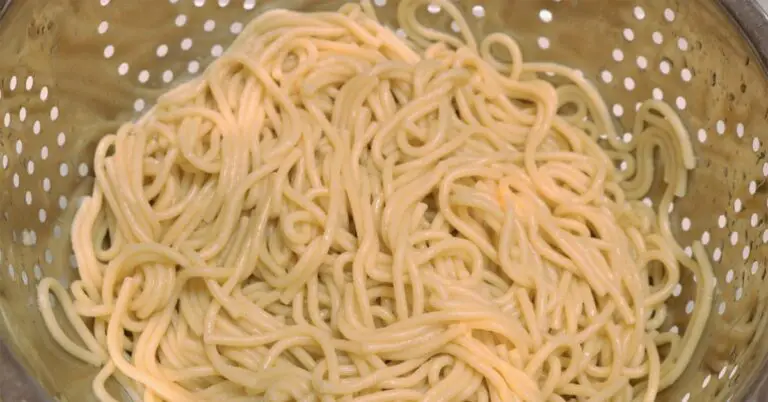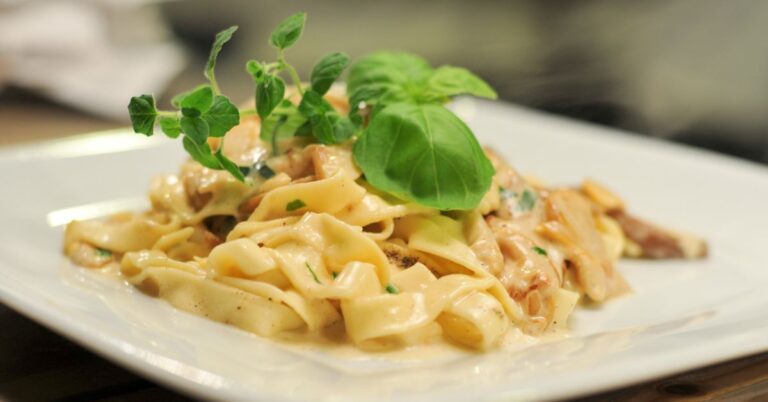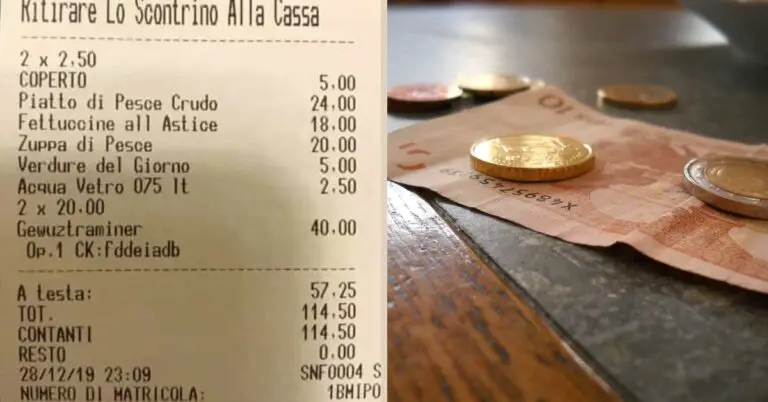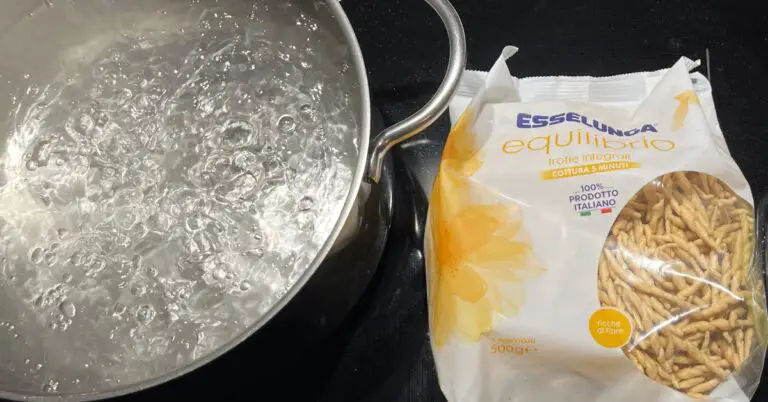Now, I will show you how we Italians traditionally cook pasta every day, when at home. In this guide, you will find all the steps, being able to see all the moves, times and tools necessary to cook pasta al dente; but above all, the advice to avoid committing small mistakes which can compromise the pasta’s cooking.
Follow these steps to cook any type of pasta, from dry to fresh, long or short, from wholemeal to legume to stuffed one.
In addition to the pasta itself, here is what you will need for the cooking phase:
- A stainless steel pot
- A ladle
- A colander
- Some coarse salt
- The sauce to season the pasta
In this tutorial, after cooking, I season pasta with pesto, but you can use any other traditional Italian sauce.
1. Put the pot with water on the stove
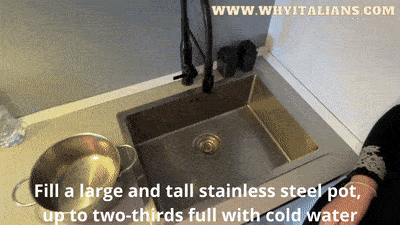
Choosing the right pot is the essential basis for cooking pasta in the correct way. You will need a steel pot wide and tall enough to contain the right amount of water so that the pasta can cook well, without sticking.
Choose the size of the pot you will need to use based on the pasta’s grams you are cooking, use this rule: every 100 grams of dry pasta requires a liter of water. Therefore, in order to cook 400 grams of pasta you need a pot that contains 4 liters of water.
Fill the pot with strictly cold tap water, adding it until it is 2/3 full of the pot.
Now you can put the pot on the stove at high power and wait for it to boil. If you have a lid put it on the pot: the water will boil sooner.
😩 ❌ Possible common mistakes at this step:
- Choosing a pot that is too small or low for the amount of pasta you want to cook can ruin the cooking phase; the same if you put too little water. These mistakes will result in a clingy mixture that sticks to the pot.
- Filling the pot with hot tap water is a mistake you should avoid: the hot water that passes through the pipes is easily richer in limestone and it could also be contaminated by bacteria. So, it is recommended to use cold tap or bottled water.
2. When it is boiling, salt the water and then throw in the pasta
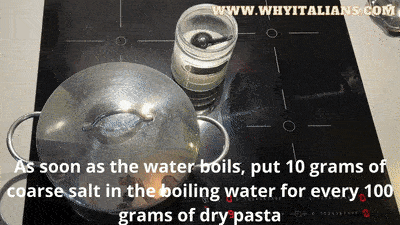
As soon as the water reaches boiling point, you can see big bubbles rising to the surface. So, it is time to salt the water, you have to put 10 grams of coarse salt in the boiling water for every 100 grams of dry pasta; you can help yourself with a teaspoon that contains just 10 grams of coarse salt.
In our case, we cooked 400 grams of pasta and then we added about 40 grams of coarse salt or 4 teaspoons of salt.
Only after you have salted the water you can pour the pasta directly from the packet into the boiling salted water. In the case of long pasta, like spaghetti, it is normal that you cannot submerge them completely immediately, wait about a minute for them to soften, then press them gently with the spoon in order to soak them completely.
Indeed, in the case of short pasta, you can directly pour it into the water and then turn it a couple of times.
As soon as the pasta is immersed in boiling salted water, you can slightly lower the power of the stove and check the necessary cooking time indicated on the pasta’s package, insert the time to know when it will be cooked so you can taste it.
😩 ❌ Possible common mistakes at this step:
- Do not add olive oil to the pasta cooking water. Contrary to what many believe, adding oil does not bring any benefits, because it does not bind with the water and will remain on the surface. It is not even useful to prevent the dough from sticking.
- Not putting salt in the water is a serious mistake that will cost you a lot. The pasta will cook but it will remain insipid and its flavor will not be enhanced. In the absence of coarse salt, you can use normal fine salt, in the same measurements indicated above.
- Be more sparing with salt if you plan to season your pasta with a specifically savory sauce, like pesto or a sauce with a lot of Parmesan or pecorino; otherwise, you risk creating an overly salty dish. In this case, 5 grams of salt for every 100 grams of pasta will do.
- Do not put the lid back on the pot once you have thrown out the pasta. With the lid closed, pasta and water inside will immediately reach a high temperature which will trigger a strong boil with the water coming out of the pot. Do not use the lid anymore now, unless you’re cooking pasta with the passive technique, in which case follow this tutorial.
- Forgetting to set the timer with the necessary cooking time is mandatory to obtain pasta al dente; otherwise, you risk cooking it well beyond the cooking time and eating overcooked pasta, or rather sticky and soggy.
3. Taste and then drain the pasta
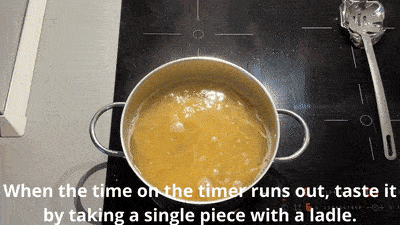
When the time on the timer runs out, or even a minute before, if you prefer your pasta to be cooked al dente, taste it by taking a single piece with a ladle.
Make sure it is fully cooked, or that it is still compact but not too hard or crunchy inside. If you feel it is too hard to bite, wait another minute of cooking and then taste it again.
Once pasta is cooked, it is ready to be drained. You can optionally save and set aside about 200 ml of cooking water (full of starch and mineral salts) by immersing in a cup. This water can be very useful for seasoning or for thinning out, particularly thick sauces.
Place a colander inside the sink and run cold tap water on one side in order to prevent the boiling water from damaging your pipes.
Pour the content of the pot into the colander and, once it has been shaken a couple of times, pour pasta back into the pot.
😩 ❌ Possible common mistakes at this step:
- Do not rinse cooked pasta with water or you will wash away all the starch wrapping pasta, which is very useful when we have to season it. Furthermore, rinsing pasta allows it to cool immediately. Read here which are the cases in which you can rinse pasta.
- Do not add olive oil to freshly drained pasta. This is because the oil will create a protective layer that will not allow the sauce added after to better be combined with pasta. At least, it is not pasta seasoned only with oil, in which case you can do it.
- Do not let pasta wait in the colander for too long before seasoning it, as the starch that covers it could dry out and become sticky until it becomes a single mass of pasta that is hard to season. Season it as soon as possible once drained.
4. Add the sauce to the pot and then plate the pasta.
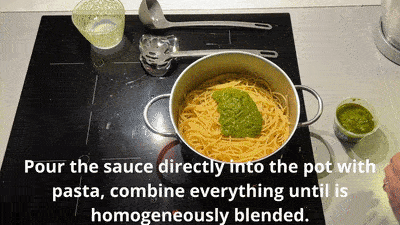
Pour the sauce directly into the pot where the pasta is still hot and combine everything until pasta is homogeneously blended with the sauce. If the sauce is excessively thick, you can add a little of the cooking water which you took from the pot before draining it, then stir until the sauce is evenly distributed throughout the pasta.
Now you can plate your pasta, usually it is used as a deep dish to eat a first course, since this type of dish holds the portion and its sauce well right in the center.
I advise you to serve about 100 grams of pasta if this single dish of pasta will be your entire meal; if, instead, it will be only the first course of a richer meal then reduce accordingly.
In the case the sauce with which you are seasoning pasta allows it, you can grate fresh Parmesan directly on the single portion on the plate or you can leave it to the diners to choose to grate it or not in their portion.
Finally, you can bring the dish to the table, but remember: to eat a plate of pasta you do not use a spoon or a knife in Italy, just a fork.
😩 ❌ Possible common mistakes at this step:
- Placing plain pasta on the plate and only then putting the sauce on top of it is wrong, as it will be difficult and uncomfortable to mix the pasta with the sauce on the plate, with a high probability of splashing over everything. So, always mix the pasta with the sauce in the pot before serving it on the plates.
- Eating pasta without seasoning is not an Italian habit, also because the starch surrounding it will cause it a sticky consistency, rather add a touch of butter or a drizzle of oil to eat the classic white pasta.
With all the shapes of pasta that exist and the different types of sauces based on vegetables, meat, fish, legumes and more, it is easy to make mistakes when pairing pasta/sauce, read here to avoid them.
Printable recipe
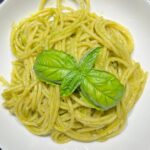
Spaghetti with pesto [how we cook it in Italy]
Equipment
- 1 A stainless steel Pot
- 1 Colander
- 1 Ladle
Ingredients
- 400 grams Spaghetti Pasta
- 40 grams Coarse Salt
- 300 grams Pesto Sauce
Instructions
- Put the pot with water on the stove Choosing the right pot is the essential basis for cooking pasta in the correct way. You will need a steel pot wide and tall enough to contain the right amount of water so that the pasta can cook well, without sticking. Choose the size of the pot you will need to use based on the pasta’s grams you are cooking, use this rule: every 100 grams of dry pasta requires a liter of water. Therefore, in order to cook 400 grams of pasta you need a pot that contains 4 liters of water. Fill the pot with strictly cold tap water, adding it until it is 2/3 full of the pot. Now you can put the pot on the stove at high power and wait for it to boil. If you have a lid put it on the pot: the water will boil sooner. 😩 ❌ Possible common mistakes at this step:Choosing a pot that is too small or low for the amount of pasta you want to cook can ruin the cooking phase; the same if you put too little water. These mistakes will result in a clingy mixture that sticks to the pot. Filling the pot with hot tap water is a mistake you should avoid: the hot water that passes through the pipes is easily richer in limestone and it could also be contaminated by bacteria. So, it is recommended to use cold tap or bottled water.
- When it is boiling, salt the water and then throw in the pastaAs soon as the water reaches boiling point, you can see big bubbles rising to the surface. So, it is time to salt the water, you have to put 10 grams of coarse salt in the boiling water for every 100 grams of dry pasta; you can help yourself with a teaspoon that contains just 10 grams of coarse salt.In our case, we cooked 400 grams of pasta and then we added about 40 grams of coarse salt or 4 teaspoons of salt. Only after you have salted the water you can pour the pasta directly from the packet into the boiling salted water. In the case of long pasta, like spaghetti, it is normal that you cannot submerge them completely immediately, wait about a minute for them to soften, then press them gently with the spoon in order to soak them completely. Indeed, in the case of short pasta, you can directly pour it into the water and then turn it a couple of times. As soon as the pasta is immersed in boiling salted water, you can slightly lower the power of the stove and check the necessary cooking time indicated on the pasta’s package, insert the time to know when it will be cooked so you can taste it. 😩 ❌ Possible common mistakes at this step:Do not add olive oil to the pasta cooking water. Contrary to what many believe, adding oil does not bring any benefits, because it does not bind with the water and will remain on the surface. It is not even useful to prevent the dough from sticking. Not putting salt in the water is a serious mistake that will cost you a lot. The pasta will cook but it will remain insipid and its flavor will not be enhanced. In the absence of coarse salt, you can use normal fine salt, in the same measurements indicated above. Be more sparing with salt if you plan to season your pasta with a specifically savory sauce, like pesto or a sauce with a lot of Parmesan or pecorino; otherwise, you risk creating an overly salty dish. In this case, 5 grams of salt for every 100 grams of pasta will do. Do not put the lid back on the pot once you have thrown out the pasta. With the lid closed, pasta and water inside will immediately reach a high temperature which will trigger a strong boil with the water coming out of the pot. Do not use the lid anymore now, unless you’re cooking pasta with the passive technique, in which case follow this tutorial.Forgetting to set the timer with the necessary cooking time is mandatory to obtain pasta al dente; otherwise, you risk cooking it well beyond the cooking time and eating overcooked pasta, or rather sticky and soggy.
- Taste and then drain the pasta When the time on the timer runs out, or even a minute before, if you prefer your pasta to be cooked al dente, taste it by taking a single piece with a ladle. Make sure it is fully cooked, or that it is still compact but not too hard or crunchy inside. If you feel it is too hard to bite, wait another minute of cooking and then taste it again. Once pasta is cooked, it is ready to be drained. You can optionally save and set aside about 200 ml of cooking water (full of starch and mineral salts) by immersing in a cup. This water can be very useful for seasoning or for thinning out, particularly thick sauces.Place a colander inside the sink and run cold tap water on one side in order to prevent the boiling water from damaging your pipes. Pour the content of the pot into the colander and, once it has been shaken a couple of times, pour pasta back into the pot. 😩 ❌ Possible common mistakes at this step:Do not rinse cooked pasta with water or you will wash away all the starch wrapping pasta, which is very useful when we have to season it. Furthermore, rinsing pasta allows it to cool immediately. Read here which are the cases in which you can rinse pasta.Do not add olive oil to freshly drained pasta. This is because the oil will create a protective layer that will not allow the sauce added after to better be combined with pasta. At least, it is not pasta seasoned only with oil, in which case you can do it. Do not let pasta wait in the colander for too long before seasoning it, as the starch that covers it could dry out and become sticky until it becomes a single mass of pasta that is hard to season. Season it as soon as possible once drained.
- Add the sauce to the pot and then plate the pasta.Pour the sauce directly into the pot where the pasta is still hot and combine everything until pasta is homogeneously blended with the sauce. If the sauce is excessively thick, you can add a little of the cooking water which you took from the pot before draining it, then stir until the sauce is evenly distributed throughout the pasta. Now you can plate your pasta, usually it is used as a deep dish to eat a first course, since this type of dish holds the portion and its sauce well right in the center. I advise you to serve about 100 grams of pasta if this single dish of pasta will be your entire meal; if, instead, it will be only the first course of a richer meal then reduce accordingly. In the case the sauce with which you are seasoning pasta allows it, you can grate fresh Parmesan directly on the single portion on the plate or you can leave it to the diners to choose to grate it or not in their portion.Finally, you can bring the dish to the table, but remember: to eat a plate of pasta you do not use a spoon or a knife in Italy, just a fork. 😩 ❌ Possible common mistakes at this step:With all the shapes of pasta that exist and the different types of sauces based on vegetables, meat, fish, legumes and more, it is easy to make mistakes when pairing pasta/sauce, read here to avoid them.Placing plain pasta on the plate and only then putting the sauce on top of it is wrong, as it will be difficult and uncomfortable to mix the pasta with the sauce on the plate, with a high probability of splashing over everything. So, always mix the pasta with the sauce in the pot before serving it on the plates. Eating pasta without seasoning is not an Italian habit, also because the starch surrounding it will cause it a sticky consistency, rather add a touch of butter or a drizzle of oil to eat the classic white pasta.

